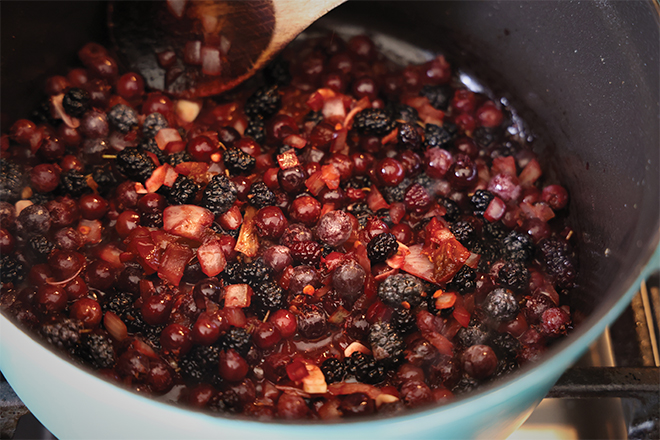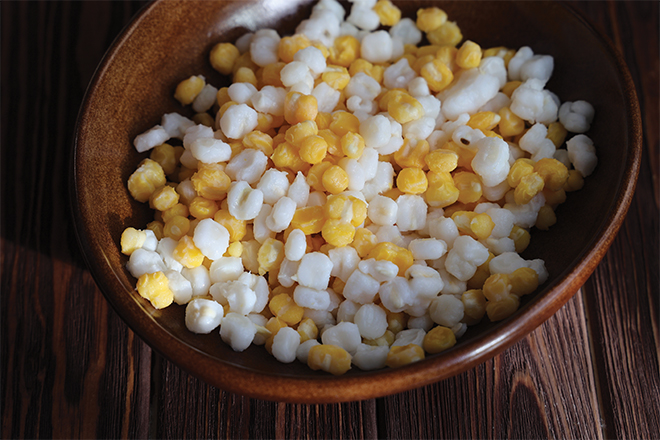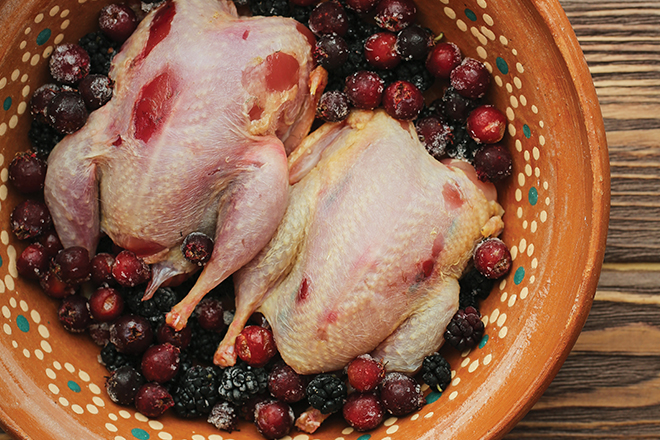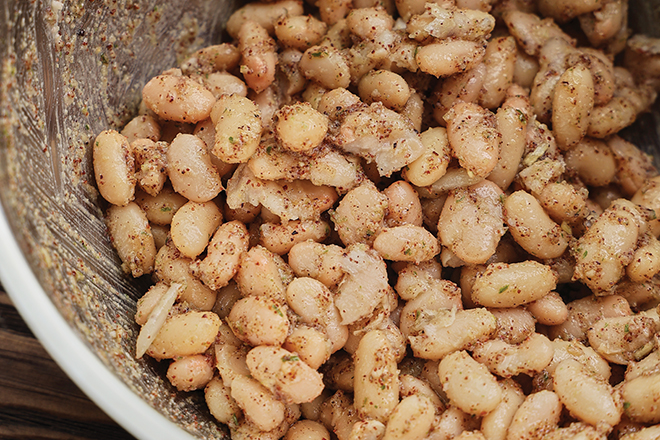A delicious recipe and a bonus history of corn
Story and photos By Jenny Nguyen-Wheatley
In my readings on Native American food, “safki” or “sofkee” caught my attention. It’s a preparation of corn, wood ash and water, primarily associated with tribes of the southeastern United States. The Muscogee (Creek) and Seminole tribes of present-day Oklahoma and Florida fermented corn to impart a sour flavor to a looser mixture of safki for drinking, and as a meal, they made a thicker porridge to eat with meat. Alongside big and small game, wild fowl such as quail, wild turkey, pigeon and waterfowl also contributed to the subsistence diets of southeastern Native American peoples.
Though you might expect an essay on preparing quail, in truth, meat plays second fiddle in this dish. Corn, after all, is more American than apple pie, and I would be remiss to squander an opportunity to share some fascinating history of this iconic grain. So, if you would bear with me, here’s the story of how safki became what we know today as grits — a delicious canvas for all manner of stewed and gravied meats, including quail.
Preparations of safki varied across different tribes, but the main elements were the same: Corn was cooked in water that was been made alkaline with wood ash, which broke down the kernel’s structure. This process is called nixtamalization, turning corn into hominy and thus enhancing its nutritional value. In the Southwest, we see a similar preparation in blue corn mush and the use of juniper ash by the Navajo. New England-area tribes had “nasaump,” which they ate with wild berries, maple syrup and nuts. And across Mesoamerica — where the process of nixtamalization began with the Aztecs — the use of hominy is alive and well today in the form of masa for tortillas and tamales, or added whole to stews like pozole or menudo.

Of course, we all know that corn saved the settlers of Jamestown from starvation. Native Americans not only introduced corn to colonists, they also taught them how free corn kernels of their tough jackets, called the pericarp, to increase the grain’s nutritional value. One way was to pound or crack corn to increase its digestibility, and the other method was to treat the corn with an alkaline solution of wood ash, which was a much more effective way to make the protein and niacin contained in corn more bioavailable.
A Southern favorite, the origins of shrimp and grits can be traced to the Muscogee tribe, who made corn mush by pounding corn, thus giving it a “gritty” texture, and soaking it in a weak lye solution made of wood ash — what is known as sakfi. Over time, this early form of grits found its way into different aspects of Southern culture. Southerners enriched their corn porridge with ingredients such as butter, cream and sugar. The Gullah Geechee, descendants of slaves from West and Central Africa who worked the coastal plantations of North Carolina, South Carolina, Florida, and Georgia, mention in their writings of meals that resembled shrimp and grits. But the grits we know today are unlike that of our colonial and Native American past. Hominy never did take hold with American cooks.
During the early half of the 20th century, the disease known as pellagra, caused by a deficiency in niacin, affected thousands all across the United States, and nowhere was pellagra more prevalent than in the South. Poor whites and Blacks ate mostly salt pork, molasses, and highly-processed cornmeal — foods with very little niacin, according to a study conducted by the National Bureau of Economic Research. Because of the dominance of cotton on the Southern economy, food production lagged behind demand, thus increasing the importation of less healthy food from other parts of the country. The expansion of the railroad also meant that food could be shipped in large quantities all over the nation.

“Historical observers often attribute the increase in pellagra to changes in the milling of Midwestern corn …,” the study noted. “The Beall degerminator, which was patented in 1900 and 1901, removed the germ. This led to a finer cornmeal with a longer shelf life, but with much less niacin and other micronutrients.”
At the disease’s peak in 1928, experts counted approximately 230,000 cases of pellagra in the American South and more than 7,000 deaths annually. Poor sharecroppers, orphans, mental-hospital patients and those living in coal-mining camps and cotton-mill towns were affected most. These populations often lacked fresh food, leaving them to rely on an unvaried diet based on cheap, nutrient-poor cornmeal. Across the pond, the production of corn as a commodity crop in Europe led to cases of pellagra two centuries prior to initial reports in the U.S. Interestingly, pellagra was not observed in Central and Native American populations.
Today, pellagra is practically unknown due to better science and subsequent laws that mandated common foods, such as bread, to be fortified with essential vitamins and minerals. Perhaps, if the process of nixtamalization had been taken more seriously by early American settlers and explorers, the devasting effects of pellagra could’ve been avoided entirely. In developing this recipe, I was not only reminded of the important role that corn has had on American history, I was also made more aware of the inventive ways in which indigenous Americans historically sought to nourish themselves, and others. In speaking of slow, intentional and nutritious food, hominy has its place alongside wild game — just as the Native Americans ate it.
The following recipe was made with Native American ingredients in mind, with a few departures. I used a mixture of wild mulberries and juneberries in the braising liquid for the quail, and my modern take on the remaining two sisters included pickling the butternut squash and roasting beans until crispy to add contrasting flavors and textures. Hominy grits completes the triad of Native American staples: corn, squash and beans — the three sisters. In aroma, taste and texture, grits prepared with hominy is distinctly different than polenta or instant grits. Hominy has a more earthy, nutty flavor, and the grits made with it is coarser, yet creamy and tender. I used canned hominy in this recipe, but I’ve read that dried hominy tends to yield a better end result, in case you have the time for that. Canned hominy can taste a bit tinny.
As written, the recipe is an involved dish — I won’t deny it. But there is a lot of room to make it your own. If you don’t want to go the berry route, stew or smother the quail and squash Southern style. I do, however, recommend that you make the crispy seasoned beans; this recipe makes extra for snacking. Sumac, a seasoning traditionally used by Native Americans, adds a vibrant pop.
I don’t claim that this is a Native American recipe by any means — it’s purely my over imagination of one. Regardless, putting together this dish was on opportune exercise in cooking with flavor combinations that I don’t normally see in mainstream American cooking, and through researching a seemingly humble ingredient – corn – I was rewarded with a small glimpse in the life and times of the ancient peoples of North America.

Recipe: Braised Quail with Hominy Grits
Servings: 4
Prep Time: 1-7 days
Cooking Time: 2 hours
Ingredients:
- 4 whole, plucked quail
- Fine sea salt
- 1 tbs. duck fat or vegetable oil
- Half a small onion, chopped
- 2 cups of wild berries
- 1 or 2 chipotle peppers in adobo sauce
- 2 cups of water, plus extra
- Sumac, to taste
- Chives/scallion/wild onion, minced
Pickled Butternut Squash
- 8 ounces peeled squash
- 1 bay leaf
- 1 dried New Mexico chili pepper
- 12 juniper berries, slightly crushed
- ½ cup white wine vinegar
- ½ cup water
- 2 tsp. fine sea salt
- 2 tsp. granulated sugar
Hominy Grits
- 2 (15.5 ounce) cans of white or golden hominy
- 1 to 1½ cups of boiled water
- ¼ tsp. fine sea salt
- 3 tbs. butter
Crispy Beans
- 2 (15.5 ounce) cans of Great Northern or Cannellini Beans
- 2 tbs. olive oil
- 2 tsp. onion salt
- 1 tsp. garlic powder
- 2 tsp. ground sumac
- ¼ tsp. fine sea salt
- 2 tsp. cornstarch
Special Equipment: pint jar, fine mesh strainer, food processor
 Directions
1.
Directions
1. To pickle butternut squash, cut peeled squash into ½-inch cubes and place them inside a pint jar along with a bay leaf, juniper berries and a New Mexico chili pepper ripped in half. In a small saucepan, heat ½ cup white wine vinegar, ½ cup water, 2 tsp. fine sea salt and 2 tsp. sugar until dissolved. Pour brine into the jar to completely submerge the squash. Allow to cool and close with a lid. Refrigerate for at least 24 hours before serving, but it’s better after a week.
2. Preheat oven to 325° F. Drain canned beans, rinse thoroughly and allow to drip dry in a colander for at least 1 hour prior to cooking. Drain canned hominy, rinse thoroughly and soak in clean water while you prepare the quail.
3. Cut out spines on quail and remove the ribs. Generously season each bird with sea salt inside and out. In a 4-quart enameled Dutch oven, or other heavy-bottomed oven-proof pot, heat duck fat over medium-high heat. Brown each quail until the skin turns golden all over and transfer to a plate.
4. Lower heat to medium and add onion, berries, chipotle pepper(s) and a pinch of salt. Sauté until onion turns translucent and berries have softened. Using a potato masher, break up the berries to release their juice and to break up the chipotle pepper. Return quail to the pot along with any juices in the dishes. Add water to reach halfway to two-thirds up the quail, about two cups, and bring to a boil. Scrape the bottom of the pan with a wooden spoon. Next, tightly cover the pot with a lid and transfer to a 325° oven, and braise quail for 1 hour. If presentation matters to you, do not allow quail breasts to touch the sauce, because the berry colors will stain the skin.
After 1 hour, remove the quail and keep warm. Push fruit, onion and cooking liquid through a fine-mesh strainer to remove solids. Return the juice back to the pot and simmer until saucy. Season to taste with salt, pepper and if needed, a bit of sugar and sumac for balance. Return the quail back to the pot and cover to keep warm.
5. To prepare the crispy beans: Preheat oven to 400° F; this is where a second or countertop oven comes in handy, but if you don’t have one, prepare the beans after the quail are done.
Use paper towels to gently remove remaining moisture on beans. Place beans in a medium mixing bowl and toss with olive oil. In a small bowl, stir to combine onion salt, garlic powder, sumac, sea salt, and cornstarch, and then toss with the beans to coat. Spread out beans on a lined cookie sheet and bake for 15 minutes, stir and then bake an additional 15 minutes or until crispy.
6. Prepare the grits right before serving: Drain the hominy that has been soaking in water and transfer to a food processor. Pulse until you get a coarse meal, and then transfer to a medium sauce pan. Turn heat to medium-low and stir until grits become heated thoroughly and start sticking to the bottom of the pan. Do not allow to scorch. Next, gradually add boiled water, stirring often, until you get the consistency that you like. Stir in butter and salt to taste. Serve immediately with quail, berry sauce, pickled butternut squash and crispy beans. Garnish with chives or green onion. Serve any extra sauce on the side to dip the quail meat.
Jenny Nguyen-Wheatley is associate editor of Nebraskaland Magazine and a frequent contributor to the magazine. She and her husband run the wild food cooking website foodforhunters.blogspot.com.
This story originally appeared in the Summer 2023 issue of Quail Forever Journal. If you enjoyed it and would like to see more delicious quail recipes in the pages of the Quail Forever Journal, become a Quail Forever member today!